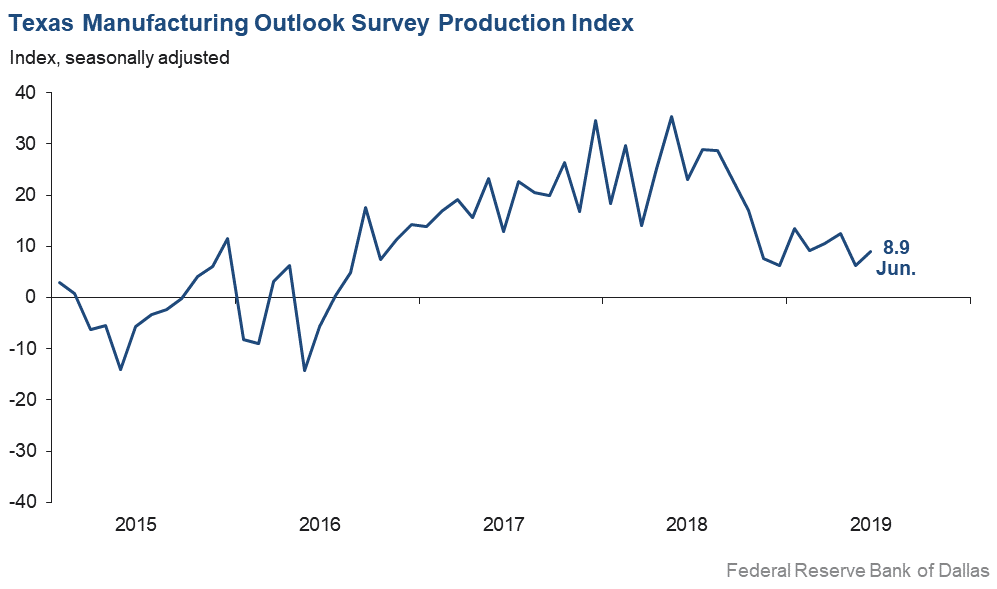
Texas Manufacturing Outlook Survey: What’s New This Month
For this month’s survey, Texas business executives were asked supplemental questions on the impact of tariffs. Results for these questions from the Texas Manufacturing Outlook Survey, Texas Service Sector Outlook Survey and Texas Retail Outlook Survey have been released together. Read the Special Questions results.
Texas factory activity continued to expand in June, according to business executives responding to the Texas Manufacturing Outlook Survey. The production index, a key measure of state manufacturing conditions, rose from 6.3 to 8.9, indicating output growth accelerated slightly from May.
Other measures of manufacturing activity exhibited mixed movements in June. The new orders index edged up to 3.7, a reading still below average. The growth rate of orders index fell eight points to -6.7, reaching its lowest reading in nearly three years.
The capacity utilization index inched up to 9.6, while the shipments index retreated six points to 1.7, a two-year low. The capital expenditures index posted a double-digit decline, falling 11 points to 6.9, also a two-year low.
Perceptions of broader business conditions shifted down again in June. The general business activity index pushed further into negative territory as more firms noted worsened activity this month than last. The index declined from -5.3 to -12.1, hitting a three-year low.
Similarly, the company outlook index fell from -1.7 to -5.5, also a three-year low. The index measuring uncertainty regarding companies’ outlooks pushed up to 21.6, its highest reading since the question was added to the survey in January 2018.
Labor market measures suggested solid, but somewhat slower, growth in employment and work hours in June. The employment index slipped from 11.6 to 8.8 but remained slightly above average.
Nineteen percent of firms noted net hiring, while 10 percent noted net layoffs. The hours worked index remained above average as well but inched down to 4.7.
Upward pressure on input costs increased in June, while pressure on selling prices remained muted and wage pressure moderated. The raw materials prices index rose nine points to 16.4.
The finished goods prices index was largely unchanged at 1.2, with the near-zero reading suggesting virtually no growth in selling prices this month. The wages and benefits index dropped five points to 22.7, closer to the long-run average for this measure.
Expectations regarding future business conditions were mixed. The index of future general business activity dropped 12 points to -2.7, with more firms expecting worsened activity six months from now than improved.
The index of future company outlook fell eight points but remained positive at 3.6. Other indexes of future manufacturing activity declined this month but stayed in positive territory.

Data were collected June 11–19, and 116 Texas manufacturers responded to the survey. The Dallas Fed conducts the Texas Manufacturing Outlook Survey monthly to obtain a timely assessment of the state’s factory activity.
Firms are asked whether output, employment, orders, prices and other indicators increased, decreased or remained unchanged over the previous month.
Survey responses are used to calculate an index for each indicator. Each index is calculated by subtracting the percentage of respondents reporting a decrease from the percentage reporting an increase.
When the share of firms reporting an increase exceeds the share reporting a decrease, the index will be greater than zero, suggesting the indicator has increased over the prior month. If the share of firms reporting a decrease exceeds the share reporting an increase, the index will be below zero, suggesting the indicator has decreased over the prior month.
An index will be zero when the number of firms reporting an increase is equal to the number of firms reporting a decrease. Data have been seasonally adjusted as necessary.
Questions regarding the Texas Manufacturing Outlook Survey can be addressed to Emily Kerr at emily.kerr@dal.frb.org.
Source: Federal Reserve Bank of Texas






